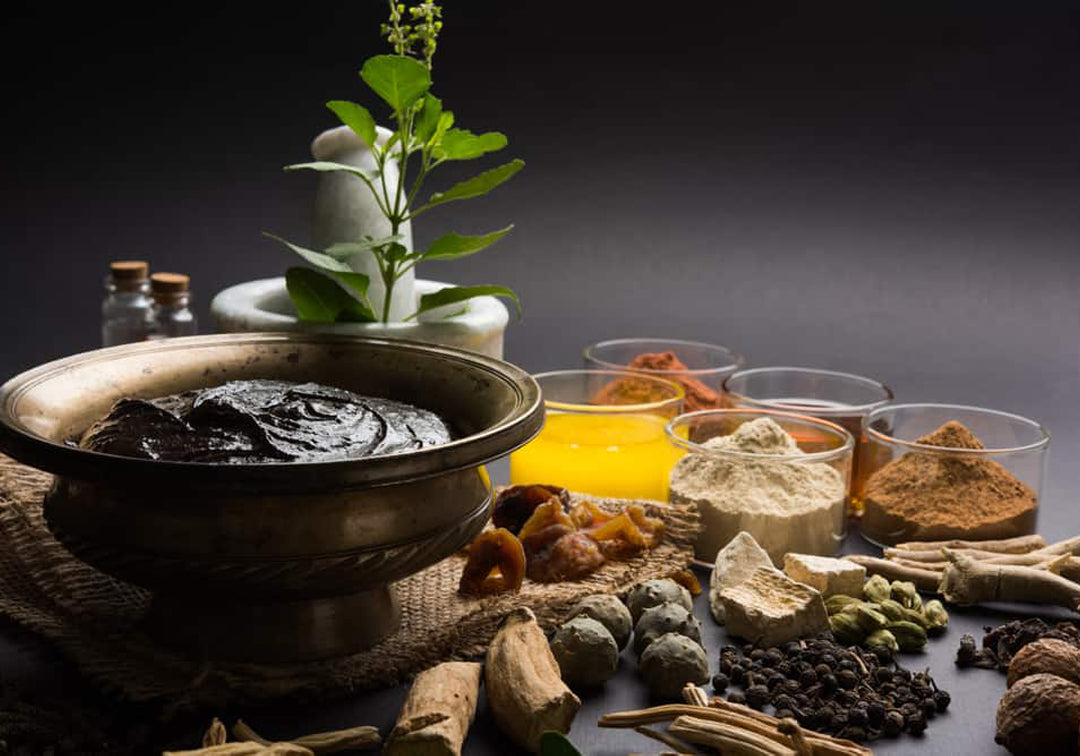OUR Ayurvedic Ingredients
 SAFFRON: golden-coloured, pungent stigmas (pollen-bearing structures) of the autumn crocus (Crocus sativus), which are dried and used as a spice to flavor foods and as a dye to color foods and other products.
SAFFRON: golden-coloured, pungent stigmas (pollen-bearing structures) of the autumn crocus (Crocus sativus), which are dried and used as a spice to flavor foods and as a dye to color foods and other products.
 ROSE PETALS: The delicate petals are rounded towards the end and come to a point. They range in size and become gradually smaller towards the center of the bloom. Rose petals are highly aromatic and may be described as similar to a basket of fruits, lemon, nasturtium or cloves.
ROSE PETALS: The delicate petals are rounded towards the end and come to a point. They range in size and become gradually smaller towards the center of the bloom. Rose petals are highly aromatic and may be described as similar to a basket of fruits, lemon, nasturtium or cloves.
 CHANDAN: Chandan is known as one of the oldest and precious plant with great fragrance. The scientific name of the plant is Santalum album. This belongs to the family Santalaceae. Chandan plant is an ever green plant that can grow up to 20 m attain girth up to 2.4 m wide with branches which are drooping and slender.
CHANDAN: Chandan is known as one of the oldest and precious plant with great fragrance. The scientific name of the plant is Santalum album. This belongs to the family Santalaceae. Chandan plant is an ever green plant that can grow up to 20 m attain girth up to 2.4 m wide with branches which are drooping and slender.
 KASTURI HALDI: Improves skin tone and the overall complexion. Gives a blemish-free, naturally glowing skin. Reduces acne and its scars effectively. Slows down the growth of facial hair.
KASTURI HALDI: Improves skin tone and the overall complexion. Gives a blemish-free, naturally glowing skin. Reduces acne and its scars effectively. Slows down the growth of facial hair.
 MANJISTHA: is a climbing or scrambling herb, with red rhizomatous base and roots. It can grow up to 150 cm (1.5 m). The stem is slender and four angled. Its leaves are rough, evergreen that whorls around its main stem in groups of 4-7, arranged in whorl of four per node and oval to heart shaped with long leaf stalk.
MANJISTHA: is a climbing or scrambling herb, with red rhizomatous base and roots. It can grow up to 150 cm (1.5 m). The stem is slender and four angled. Its leaves are rough, evergreen that whorls around its main stem in groups of 4-7, arranged in whorl of four per node and oval to heart shaped with long leaf stalk.
 ALOE VERA: Aloe vera is a stemless or very short-stemmed plant growing to 60–100 cm (24–39 in) tall, spreading by offsets. The leaves are thick and fleshy, green to grey-green, with some varieties showing white flecks on their upper and lower stem surfaces. The margin of the leaf is serrated and has small white teeth.
ALOE VERA: Aloe vera is a stemless or very short-stemmed plant growing to 60–100 cm (24–39 in) tall, spreading by offsets. The leaves are thick and fleshy, green to grey-green, with some varieties showing white flecks on their upper and lower stem surfaces. The margin of the leaf is serrated and has small white teeth.
 VETIVER: is a large tufted bunchgrass and can reach up to 1.5 metres (5 feet) in height. The thin leaves and stems are erect and rigid, and the plant bears small brown-purple flowers in long spikes. The fragrant roots grow downward in the soil and can attain depths of more than 3 metres (10 feet).
VETIVER: is a large tufted bunchgrass and can reach up to 1.5 metres (5 feet) in height. The thin leaves and stems are erect and rigid, and the plant bears small brown-purple flowers in long spikes. The fragrant roots grow downward in the soil and can attain depths of more than 3 metres (10 feet).
 LOTUS EXTRACT: The flowers, seed, leaves, and parts of the underground stem (rhizome) are used to make medicine. Lotus flowers are used to stop bleeding. Lotus seeds are used for disorders of the digestive tract, including diarrhea.
LOTUS EXTRACT: The flowers, seed, leaves, and parts of the underground stem (rhizome) are used to make medicine. Lotus flowers are used to stop bleeding. Lotus seeds are used for disorders of the digestive tract, including diarrhea.
 LIQUORICE: is an extract from the Glycyrrhiza glabra plant which contains glycyrrhizic acid, or GZA. GZA is made of one molecule of glycyrrhetinic acid and two molecules of glucuronic acid. The extracts from the root of the plant can also be referred to as liquorice, sweet root, and glycyrrhiza extract.
LIQUORICE: is an extract from the Glycyrrhiza glabra plant which contains glycyrrhizic acid, or GZA. GZA is made of one molecule of glycyrrhetinic acid and two molecules of glucuronic acid. The extracts from the root of the plant can also be referred to as liquorice, sweet root, and glycyrrhiza extract.
 NEEM: Azadirachta indica, commonly known as neem, nimtree or Indian lilac, is a tree in the mahogany family Meliaceae. It is one of two species in the genus Azadirachta, and is native to the Indian subcontinent. It is typically grown in tropical and semi-tropical regions.
NEEM: Azadirachta indica, commonly known as neem, nimtree or Indian lilac, is a tree in the mahogany family Meliaceae. It is one of two species in the genus Azadirachta, and is native to the Indian subcontinent. It is typically grown in tropical and semi-tropical regions.
 AMLA: Amla are small, round berries with light-green skin. The skin is almost translucent, with 6 to 8 faint yellow striations, making the Amla appear to be segmented. The skin is tough, yet thin with a flesh that is crisp and juicy with a taste both sour and bitter. The flesh of an Amla is also somewhat astringent.
AMLA: Amla are small, round berries with light-green skin. The skin is almost translucent, with 6 to 8 faint yellow striations, making the Amla appear to be segmented. The skin is tough, yet thin with a flesh that is crisp and juicy with a taste both sour and bitter. The flesh of an Amla is also somewhat astringent.
 MANDHARA: This flowers have bloomed any season Mandar is also called Chinese Buddhist flower because they used this flowers for worship in chine. Mandara flowers and leaves are used in medicine and Ayurvedic as used for growing Hair and skin diseases, stomachache.
MANDHARA: This flowers have bloomed any season Mandar is also called Chinese Buddhist flower because they used this flowers for worship in chine. Mandara flowers and leaves are used in medicine and Ayurvedic as used for growing Hair and skin diseases, stomachache.
 Onion: Allium cepa, is an herbaceous biennial in the family Liliaceae grown for its edible bulb. The stem of the plant is a flattened disc at the base and the tubular leaves form a pseudostem where their sheaths overlap. ... They are generally oval but shape can be variable and occur in clusters of 3–18 to a plant.
Onion: Allium cepa, is an herbaceous biennial in the family Liliaceae grown for its edible bulb. The stem of the plant is a flattened disc at the base and the tubular leaves form a pseudostem where their sheaths overlap. ... They are generally oval but shape can be variable and occur in clusters of 3–18 to a plant.
 BRAHMI: Bacopa monnieri, also called brahmi, water hyssop, thyme-leaved gratiola, and herb of grace, is a staple plant in traditional Ayurvedic medicine. It grows in wet, tropical environments, and its ability to thrive underwater makes it popular for aquarium use
BRAHMI: Bacopa monnieri, also called brahmi, water hyssop, thyme-leaved gratiola, and herb of grace, is a staple plant in traditional Ayurvedic medicine. It grows in wet, tropical environments, and its ability to thrive underwater makes it popular for aquarium use
 REETHA: is a common tree in Shivalik Hills and the outer Himalayas. It is a deciduous tree, growing to 25 m tall. Reetha leaves are long stalked odd pinnate. The leaf spine is nearly 30-50 cm long and bears 5 to 10 pairs of leaflets. An individual leaflet is about 7-15 cm long and 2-5 cm wide.
REETHA: is a common tree in Shivalik Hills and the outer Himalayas. It is a deciduous tree, growing to 25 m tall. Reetha leaves are long stalked odd pinnate. The leaf spine is nearly 30-50 cm long and bears 5 to 10 pairs of leaflets. An individual leaflet is about 7-15 cm long and 2-5 cm wide.
 SHIKAKAI: is a climbing plant, known, since ancient times, for the natural shampoo derived from its fruit. The branches are thorny and have brown smooth stripes with pink flowers. Leaves are double pinnate like a fern but rounder in shape.
SHIKAKAI: is a climbing plant, known, since ancient times, for the natural shampoo derived from its fruit. The branches are thorny and have brown smooth stripes with pink flowers. Leaves are double pinnate like a fern but rounder in shape.
 CURRY LEAVES: Murraya koenigii, called curry leaf, is a small, tropical to sub-tropical tree or shrub that typically grows to 6-15' tall and is noted for its pungent, aromatic, curry leaves which are an important flavoring used in Indian/Asian cuisine. ... Curry leaves are often added to vegetable dishes
CURRY LEAVES: Murraya koenigii, called curry leaf, is a small, tropical to sub-tropical tree or shrub that typically grows to 6-15' tall and is noted for its pungent, aromatic, curry leaves which are an important flavoring used in Indian/Asian cuisine. ... Curry leaves are often added to vegetable dishes
 JATHAMANSI: (Nardostachys Jatamansi) is a perennial herb about 10-60cm in height having long stout, rhizomes root. The leaves are elongated and spatulated while few leaves are sessile, oblong or sub ovate. The flowers are pink bell shaped. Its roots are thick and has too many hairs.
JATHAMANSI: (Nardostachys Jatamansi) is a perennial herb about 10-60cm in height having long stout, rhizomes root. The leaves are elongated and spatulated while few leaves are sessile, oblong or sub ovate. The flowers are pink bell shaped. Its roots are thick and has too many hairs. FENUGREEK: Fenugreek, Trigonella foenum-graecum, is an herbaceous annual plant in the family Fabaceae grown for its leaves and seeds which are used as a herb or spice. The fenugreek plant may have a single stem or may be branched at the stem base. The plant has an erect growth habit and a strong, sweet aroma.
FENUGREEK: Fenugreek, Trigonella foenum-graecum, is an herbaceous annual plant in the family Fabaceae grown for its leaves and seeds which are used as a herb or spice. The fenugreek plant may have a single stem or may be branched at the stem base. The plant has an erect growth habit and a strong, sweet aroma.
&Other Ingredients
 Henna : Henna is a dye prepared from the plant Lawsonia inermis, also known as the henna tree, the mignonette tree, and the Egyptian privet,the sole species of the genus Lawsonia.Henna can also refer to the temporary body art resulting from the staining of the skin from the dyes.
Henna : Henna is a dye prepared from the plant Lawsonia inermis, also known as the henna tree, the mignonette tree, and the Egyptian privet,the sole species of the genus Lawsonia.Henna can also refer to the temporary body art resulting from the staining of the skin from the dyes.


